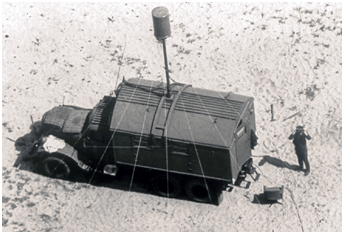
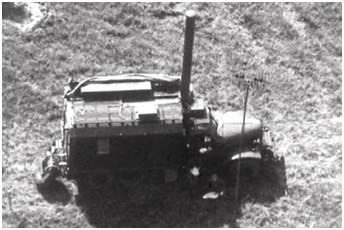 « This resulted in much closer photos that were hand-focused at 1000 AGL (no automatic focus cameras were available in the 1970s). One had to concentrate, because the 500mm and 1000mm
lens on the Nikon F motor-driven body could eat up the 36 frames of a Tri-X 35mm film in a very few seconds. By putting the wing over and circling a target, we were able to capture
many pictures of the same subject, which could then be viewed by special optics that yielded three-dimensional views and provided intelligence analysts with more information.
We even were able to look down into the interior of such targets as tanks, self-propelled artillery, and armored personnel carriers. The aircraft transponder, which sent our position
and altitude to Berlin air traffic controllers, sometimes "accidently" failed to work on such occasions and the pilots would receive a radio call notifying him that they had lost contact
with us. It was always interesting that the transponder would magically come to life again when we reached 1000-feet AGL. The full-frame, better-quality pictures sometimes resulted
in questions from Colonel Thorsen as to how we were able to obtain such great pictures at 1000 AGL. (I don't remember SSgt St. John's superiors ever asking that question.)
My response to Colonel Thorsen was that it was just the effect of flying at 1000 ft. AGL using a 1000mm lens that makes it look like you're only one-foot away. He'd only smile,
shake his head, and walk away. He had been a military attaché in Warsaw, so knew very well that attachés and USMLM Air and Ground tour officers sometime took chances in order to succeed.
And, sometimes it just was the better part of valor to not tell all...
« This resulted in much closer photos that were hand-focused at 1000 AGL (no automatic focus cameras were available in the 1970s). One had to concentrate, because the 500mm and 1000mm
lens on the Nikon F motor-driven body could eat up the 36 frames of a Tri-X 35mm film in a very few seconds. By putting the wing over and circling a target, we were able to capture
many pictures of the same subject, which could then be viewed by special optics that yielded three-dimensional views and provided intelligence analysts with more information.
We even were able to look down into the interior of such targets as tanks, self-propelled artillery, and armored personnel carriers. The aircraft transponder, which sent our position
and altitude to Berlin air traffic controllers, sometimes "accidently" failed to work on such occasions and the pilots would receive a radio call notifying him that they had lost contact
with us. It was always interesting that the transponder would magically come to life again when we reached 1000-feet AGL. The full-frame, better-quality pictures sometimes resulted
in questions from Colonel Thorsen as to how we were able to obtain such great pictures at 1000 AGL. (I don't remember SSgt St. John's superiors ever asking that question.)
My response to Colonel Thorsen was that it was just the effect of flying at 1000 ft. AGL using a 1000mm lens that makes it look like you're only one-foot away. He'd only smile,
shake his head, and walk away. He had been a military attaché in Warsaw, so knew very well that attachés and USMLM Air and Ground tour officers sometime took chances in order to succeed.
And, sometimes it just was the better part of valor to not tell all...
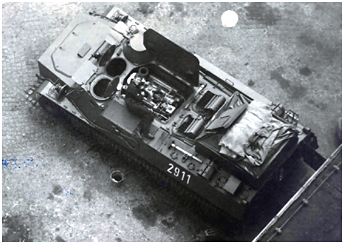 There were several intelligence-gathering advantages to the Larkspur program. Primarily, our aerial photographs presented equipment in a totally different perspective and provided
details for analysts that satellites at the time could not obtain. They supplemented any ground-level views and gave a fuller picture of capabilities. Secondly, we enjoyed relative
safety as compared to being detained, run off roads, assaulted, and especially being shot at by the Soviets and East Germans. However, it was not unusual to have weapons pointed at us and,
more frequently, flare guns fired at the aircraft. The pilots had complete freedom to fly the plane as necessary to avoid flares, other aircraft, and so on. This allowed Sgt. St. John and me,
who served as aircraft crewmen observers and photographers, to concentrate on our targets. After flying missions in the ring for several months, we were able to discern patterns of behavior
such as what days training took place and where, what days were wash days, maintenance days, and inspection days, and so forth. Understanding these patterns helped guide us in our
collection efforts. Our observations also enabled us to provide subjective comments and personal analysis of activities, tactics, and training that a desk analyst could not do as well
as someone who actually had eyes on the target. »
There were several intelligence-gathering advantages to the Larkspur program. Primarily, our aerial photographs presented equipment in a totally different perspective and provided
details for analysts that satellites at the time could not obtain. They supplemented any ground-level views and gave a fuller picture of capabilities. Secondly, we enjoyed relative
safety as compared to being detained, run off roads, assaulted, and especially being shot at by the Soviets and East Germans. However, it was not unusual to have weapons pointed at us and,
more frequently, flare guns fired at the aircraft. The pilots had complete freedom to fly the plane as necessary to avoid flares, other aircraft, and so on. This allowed Sgt. St. John and me,
who served as aircraft crewmen observers and photographers, to concentrate on our targets. After flying missions in the ring for several months, we were able to discern patterns of behavior
such as what days training took place and where, what days were wash days, maintenance days, and inspection days, and so forth. Understanding these patterns helped guide us in our
collection efforts. Our observations also enabled us to provide subjective comments and personal analysis of activities, tactics, and training that a desk analyst could not do as well
as someone who actually had eyes on the target. »
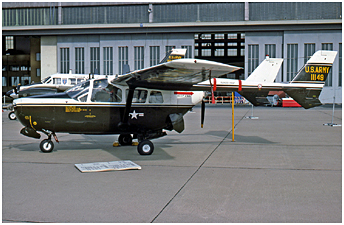
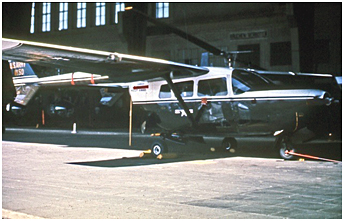 In the mid-seventies, the Beaver were still active, however, two Cessna O-2A Super Skymaster also were assigned to USCOB in 1975. Having twin engines enabled the O-2 to lose one engine
and still return safely, endearing it to its crews. However, the Beaver was preferred over the Skymaster, because it had more forgiving handling, a slower stall speed, better stall
recovery characteristics, offered better observation for aerial photography (especially with both rear trapezoid windows removed), and was quieter than the double-engine Skymaster.
Spare parts supply was a problem because the Beaver production had ended in 1967 and the last-built Skymaster left the factory in June 1970.
In 1976, Major Michael Crutcher who was trained by Thomas Spencer, not only took over the program, but reorganized it to be one of the most productive USMLM intelligence programs.
A former Marine Corps officer recalls:
In the mid-seventies, the Beaver were still active, however, two Cessna O-2A Super Skymaster also were assigned to USCOB in 1975. Having twin engines enabled the O-2 to lose one engine
and still return safely, endearing it to its crews. However, the Beaver was preferred over the Skymaster, because it had more forgiving handling, a slower stall speed, better stall
recovery characteristics, offered better observation for aerial photography (especially with both rear trapezoid windows removed), and was quieter than the double-engine Skymaster.
Spare parts supply was a problem because the Beaver production had ended in 1967 and the last-built Skymaster left the factory in June 1970.
In 1976, Major Michael Crutcher who was trained by Thomas Spencer, not only took over the program, but reorganized it to be one of the most productive USMLM intelligence programs.
A former Marine Corps officer recalls:
« Until ca. July of 1979 USMLM essentially ran the program. USMLM's Joint Division, which bore operational responsibility, was led by one of my
predecessors as NavRep (1), John Guenther; the Chief of Mission purposely and consciously appointed him because of the internecine
feuding in which the Army and Air Force Elements engaged during those years. The aircraft and pilots always came from the assets of the Berlin Brigade, but targeting and report writing
belonged to the Mission. For that purpose the Mission created the Joint Division largely out of hide; it was not large, but I can't tell exactly how many personnel were involved.
Thanks to John's efforts, the Marine Corps actually provided two additional personnel to MLM - a highly decorated captain/reconnaissance officer and a master sergeant/intel
specialist - for the effort. In 1979 a transfer of responsibility for operational planning and reporting from USMLM to the intelligence section of the Berlin Brigade was effected for
internal reasons. »
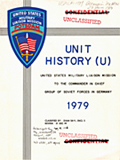 |
USMLM Unit History, 1979 - extract JOINT DIVISION COLLECTION ACTIVITIES (NOTE: All succeeding subparagraphs of this section are classified CONFIDENTIAL) 1. General: During the period 01 JAN - 20 MAR 79, Joint Division, as the operations element of the USMLM/ODCSI USCOB Project LARKSPUR, planned and participatted in 15 aerial reconnaisance missions in the Berlin Control Zone. Twenty-three Intelligence Information Reports based on information acquired during these missions were submitted. On 20 MAR 79, a 90 day test period, directed by DCSI USAREUR, which involved shifting the responsability for both the coordination and the operation of LARKSPUR entirely to ODCSI USCOB, began. On 12 JUL 79, the test period ended, and USMLM participation in the program terminated. |
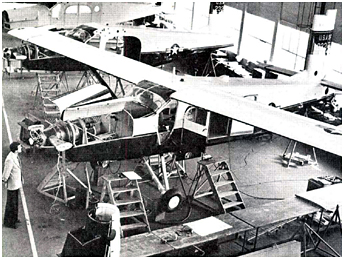
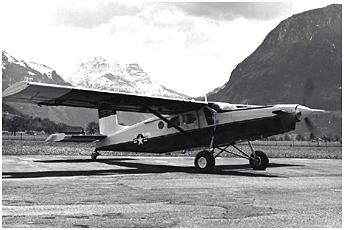 It seems that the last Beaver was decommissioned in 1982. The "Berlin Observer" of May 14, 1982 (a USCOB publication) announced that a Beaver indeed was given to the new Berlin Transportation
Museum. The article stated: "This particular plane, was used in the command [understand USCOB] from 1973 to 1979 for transportation of cargo and personnel between Berlin and West Germany and
for pilot training. But Beavers had been in Berlin since 1962." A fine example of information concealment...
The Cessna O-2A were in turn replaced in 1979 by two brand new Pilatus PC-6/B2-H2, of which the military designation was UV-20A Chiricahua. These aircraft were not randomly selected
and they were the subject of special modifications. The two windows of the sliding door on the right side indeed were replaced by a single large rectangular window to facilitate photography
- it was without doubt optically flat. For the same purpose, the right exhaust nozzle of the Pratt & Whitney PT6A turboprop was extended downwards to deflect the hot exhaust gases that would
otherwise have caused blurred pictures. We can conclude from the available pictures that this change was not performed in the Pilatus factory. However, it is believed that the door was mostly
open during missions.
Lieutenant Colonel (Ret.) Tim Bloechl says: « The program was run by the Office of the Deputy Chief of Staff, Intelligence (ODCSI). I led the mission and program from August 1984 to
December 1986. As an Army Captain, I was the Reconnaissance and Surveillance Officer for ODCSI, USCOB and had responsibility for this program, the Soviet Sector Flag Tours
(ground tours into East Berlin/missions similar to USMLM) (2), and one other project. The Aviation Detachment was in direct support
to ODCSI and all of my soldiers had to go through crewmember training and pass flight physicals to be on the missions.
The Detachment had a complement of warrant officers as pilots for our missions under the command of a major.
There was a spirit of great comradery between these pilots and the 8-10 soldiers from ODCSI who flew the missions as crewmembers/observers.
It seems that the last Beaver was decommissioned in 1982. The "Berlin Observer" of May 14, 1982 (a USCOB publication) announced that a Beaver indeed was given to the new Berlin Transportation
Museum. The article stated: "This particular plane, was used in the command [understand USCOB] from 1973 to 1979 for transportation of cargo and personnel between Berlin and West Germany and
for pilot training. But Beavers had been in Berlin since 1962." A fine example of information concealment...
The Cessna O-2A were in turn replaced in 1979 by two brand new Pilatus PC-6/B2-H2, of which the military designation was UV-20A Chiricahua. These aircraft were not randomly selected
and they were the subject of special modifications. The two windows of the sliding door on the right side indeed were replaced by a single large rectangular window to facilitate photography
- it was without doubt optically flat. For the same purpose, the right exhaust nozzle of the Pratt & Whitney PT6A turboprop was extended downwards to deflect the hot exhaust gases that would
otherwise have caused blurred pictures. We can conclude from the available pictures that this change was not performed in the Pilatus factory. However, it is believed that the door was mostly
open during missions.
Lieutenant Colonel (Ret.) Tim Bloechl says: « The program was run by the Office of the Deputy Chief of Staff, Intelligence (ODCSI). I led the mission and program from August 1984 to
December 1986. As an Army Captain, I was the Reconnaissance and Surveillance Officer for ODCSI, USCOB and had responsibility for this program, the Soviet Sector Flag Tours
(ground tours into East Berlin/missions similar to USMLM) (2), and one other project. The Aviation Detachment was in direct support
to ODCSI and all of my soldiers had to go through crewmember training and pass flight physicals to be on the missions.
The Detachment had a complement of warrant officers as pilots for our missions under the command of a major.
There was a spirit of great comradery between these pilots and the 8-10 soldiers from ODCSI who flew the missions as crewmembers/observers.
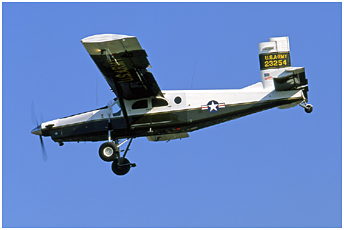
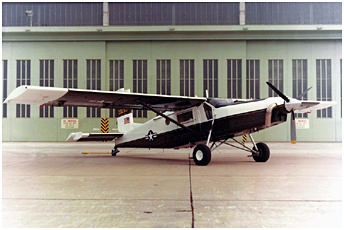 Additionally, we were sometimes asked to take special visitors on our flights so they could get a unique look at the Berlin environment.
I remember on one occasion the U.S. Ambassador to Germany along for the ride. It was a very interesting duty tour and, coupled with the Soviet Sector Flag Tours operation,
made for one of the finest intelligence assignments I had in my career.
Each Ally, if weather was OK, ran 17 missions a month/365 days a year.
Given the cloud cover and fog in the vicinity of Berlin we rarely were able to run all missions. We planned our own missions without USMLM direction, however we did coordinate with them
routinely as we saw things and they saw things. Observations did have impacts on our flight plans which were grease pencil marks on maps. We flew all missions within the Berlin Control Zone.
The flight altitude was routinely 1000 FT (when deemed important to mission execution, we flew below 1000 FT to as low as 500FT for short periods) and 3000 FT over the airfields.
The MiGs used to routinely buzz us to mess with us. We sat sideways in the plane and opening the door - left to right -
to hang out and take pictures. Call signs were "Freedom City 253" or "254" (whichever plane was used on the mission that day) and this corresponded to the tail number on the plane
[s/n 802 79-23253 et s/n 803 79-23254]. We all coordinated flight plans with each other so each Ally had a plane in the air every half day based on a schedule promulgated by Allied Command,
Berlin.
Additionally, we were sometimes asked to take special visitors on our flights so they could get a unique look at the Berlin environment.
I remember on one occasion the U.S. Ambassador to Germany along for the ride. It was a very interesting duty tour and, coupled with the Soviet Sector Flag Tours operation,
made for one of the finest intelligence assignments I had in my career.
Each Ally, if weather was OK, ran 17 missions a month/365 days a year.
Given the cloud cover and fog in the vicinity of Berlin we rarely were able to run all missions. We planned our own missions without USMLM direction, however we did coordinate with them
routinely as we saw things and they saw things. Observations did have impacts on our flight plans which were grease pencil marks on maps. We flew all missions within the Berlin Control Zone.
The flight altitude was routinely 1000 FT (when deemed important to mission execution, we flew below 1000 FT to as low as 500FT for short periods) and 3000 FT over the airfields.
The MiGs used to routinely buzz us to mess with us. We sat sideways in the plane and opening the door - left to right -
to hang out and take pictures. Call signs were "Freedom City 253" or "254" (whichever plane was used on the mission that day) and this corresponded to the tail number on the plane
[s/n 802 79-23253 et s/n 803 79-23254]. We all coordinated flight plans with each other so each Ally had a plane in the air every half day based on a schedule promulgated by Allied Command,
Berlin.
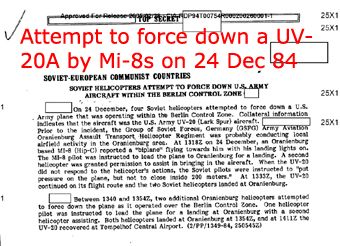 During these years we used Nikon F3 cameras with lenses as large as 1000mm. At 1000 feet with that lens, and the great turning maneuvers conducted by our pilots, a T-64 tank would spin in
the viewer allowing for lots of great shots.
The aerial view of Soviet and East German facilities also provided a perspective of the difference between these forces. Soviet garrisons were often untidy and poorly maintained.
Indeed, when one flew over the aircraft hangars at Oranienburg, you could look through the holes in the roof to count the helicopters housed inside. Trash was everywhere making for potentially
lucrative targets for USMLM [Sanddune program]. On the other hand, the East German barracks were very well maintained. One could sense a higher degree of discipline and morale within the East German forces.
As one historical point, Major Arthur Nicholson was in the plane with me the day before he was shot and killed (3).
Periodically USMLM officers would go on missions with us to check areas they were thinking about checking out the next day on the ground.
On another occasion, in December of 1985 is I recall correctly, while in the vicinity of Oranienburg Airfield, three Soviet helicopters tried to interfere with our flight and
it appeared to the pilot and crewmembers it was an attempt to force the plane down. So the plane left the area for a time, but when the crew felt the coast was clear, went right back
to the airfield to see what they might be hiding. Our higher HQs was not very happy that they did so! Otherwise, we largely conducted each mission without incident.
Our biggest challenge was usually weather. Low cloud ceilings and reduced visibility, particularly in the winter months, caused many mission cancellations.
Also during the winter, it got awfully cold with the side door open on the plane! »
During these years we used Nikon F3 cameras with lenses as large as 1000mm. At 1000 feet with that lens, and the great turning maneuvers conducted by our pilots, a T-64 tank would spin in
the viewer allowing for lots of great shots.
The aerial view of Soviet and East German facilities also provided a perspective of the difference between these forces. Soviet garrisons were often untidy and poorly maintained.
Indeed, when one flew over the aircraft hangars at Oranienburg, you could look through the holes in the roof to count the helicopters housed inside. Trash was everywhere making for potentially
lucrative targets for USMLM [Sanddune program]. On the other hand, the East German barracks were very well maintained. One could sense a higher degree of discipline and morale within the East German forces.
As one historical point, Major Arthur Nicholson was in the plane with me the day before he was shot and killed (3).
Periodically USMLM officers would go on missions with us to check areas they were thinking about checking out the next day on the ground.
On another occasion, in December of 1985 is I recall correctly, while in the vicinity of Oranienburg Airfield, three Soviet helicopters tried to interfere with our flight and
it appeared to the pilot and crewmembers it was an attempt to force the plane down. So the plane left the area for a time, but when the crew felt the coast was clear, went right back
to the airfield to see what they might be hiding. Our higher HQs was not very happy that they did so! Otherwise, we largely conducted each mission without incident.
Our biggest challenge was usually weather. Low cloud ceilings and reduced visibility, particularly in the winter months, caused many mission cancellations.
Also during the winter, it got awfully cold with the side door open on the plane! »
The two Chiricahua left Berlin in August 1991 to be assigned to the Golden Knights parachute demonstration team of the US Army based in Fort Bragg (NC)
(4).
~~~~~~~~~~~~~~~~~~~~~~~~~
Writing this article would have been impossible without the help of Bill Burhans (USMLM), Thomas Spencer (USMLM), Nicholas Troyan (USMLM) and Tim Bloechl (USCOB).
~~~~~~~~~~~~~~~~~~~~~~~~~
notes
(1)
The USMLM Naval Representative 1949-1990 > LINK.
(2)
Tim Bloechl explains: The term "Flag Tours" refers to the official title of the U.S. mission "Soviet Sector Flag Tours."
This was another mission run by
ODCSI, USCOB. The French and British allies ran similar missions out of their respective sectors.
The "official" purpose of these tours under treaty
was to maintain access rights into and out of East Berlin from West Berlin.
While normal Allied crossings into East Berlin were through Checkpoint
Charlie, primarily so the Allies could keep track of U.S., French and British personnel,
the Flag Tour missions were free to use all crossing points of
which there were several, including the U-Bahn underground station at Frederickstrasse.
Allied sedans had their appropriate flags painted on their
vehicles to clearly identify these vehicles to Soviet and East German authorities.
Personnel travelled in Class B or Class A uniforms. Flag Tour
missions were restricted to the confines of East Berlin, much in the same way as MLM missions were
restricted to East Germany, less East Berlin. The
MLM and Flag Tour missions were completely separate, however, information sharing occurred between all the parties.
On occasion, U.S., French,
and British tour members even travelled together in each other's vehicles and adjusted who was in each vehicle once across to
confuse border
guards. Also, during periods of increased activity or interest, the Allies coordinated their operations in East Berlin.
This included a quarterly probe
where the Allied Flag Tour officers, accompanied by officers of Allied Command, Berlin, would gather at Checkpoint Charlie,
use the nearby U-Bahn
underground station at Kochstrasse, and enter East Berlin at the Frederickstrasse underground station.
Once above a great lunch was in store at Hotel
Kempinski in the East Berlin. Chateaubriand lunch will all the trimmings and wine for about 10 East German Marks ($2 to $3 USD).
(3)
Major Arthur D. Nicholson was shot and killed by a Soviet sentry near Ludwigsluft on March 24, 1985 > LINK.
(4)
"253" had a mid-air collision with a Cessna 182 on March 15, 2002 above Marana (AZ). The latter managed to land,
but the Pilatus crashed killing its pilot.
"254" was assigned to the United States Army Special Operations Command (USASOC)
"Black Daggers" parachute team in 2004.
 |
Operation Larkspur < Part 1 |
 |
Plan du site - Sitemap |  |
